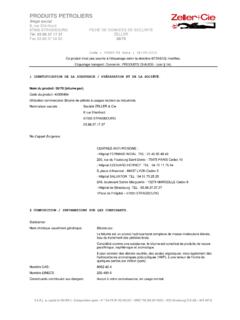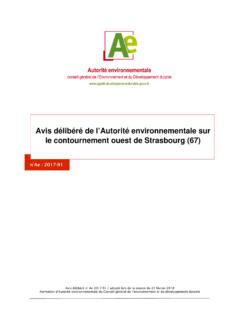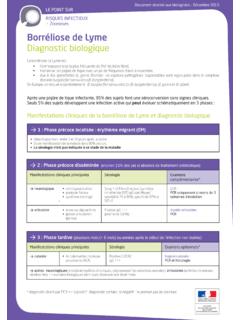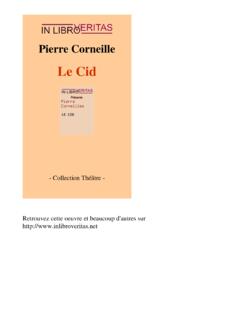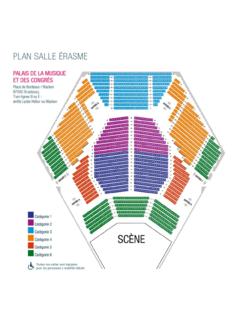Transcription of Garry Trillet Master student at CEIPI, University of ...
1 Garry Trillet Master student at CEIPI, University of Strasbourg, France Table of content 1. Introduction .. 3 2. Smell marks .. 6 3. Color 8 Single color, a color alone, color per se and more .. 8 Combination of colors .. 11 Acquired distinctiveness or secondary meaning .. 12 Conclusion .. 13 4. Sound marks .. 14 5. Conclusion .. 17 6. Limitations and further research .. 20 Bibliography .. 21 3 1. Introduction A trade mark can be described as a sign or symbol placed on, or used in relation to, one trader s goods or services to distinguish them from similar goods or services supplied by other traders. 1 Trademark2 is often perceived in a traditional sense as a two-dimensional word, slogan, symbol etc. employed to distinguish a product or service. Indeed, about 106,000 trademarks applications (2011) were filed at the Office for Harmonization in the Internal Market (OHIM)3 where the vast majority of Community Trademarks consists of word marks ( ) and figurative marks ( ).
2 4 In today s world, companies have to be creative and stand out from their competitors to remain in a good market position. Companies must invest, besides a word trademark, into so-called non-traditional trademarks, such as smell, sound and color marks applied, for example, on the products packaging to make it depart significantly from the sector s norms. Indeed, in order to have a viable future, brands will have to incorporate a brand platform that fully integrates the five senses ,5 where virtually any perceptible feature in the sensory world can be used to attract custom .6 Moreover, marketing and branding methods are growing into a farfetched way as companies start to surf on the social media movement of our information Besides, traders also invest into the circulation of the brand image like Apple which registered its cube-shaped glass store in New However, traders need to be careful, as educating consumers to associate a particular color, smell, sound, etc.
3 With a brand demand huge expenditures in marketing and communication, where cleverness alone does not ensure legal protection .9 Also, non-conventional trademarks (NCTMs) pose a marketing dilemma , using them in a sensory marketing could sound the legal death knell for the trademark itself as it will not fulfill its source indicator New technologies brought the possibility to exploit a different type of marks and globalization has stimulated the utilization of these non-verbal signs because of their autonomy from linguistic 1 Hart, T., Fazzani, L. and Clark, S., 2009. Intellectual Property Law, 5th ed., Palgrave Macmillan, chapter 8, p. 79. 2 Throughout this work, trademark and mark will be used to refer to both trademarks and service marks. 3 OHIM Annual Report 2011, Available from: [Accessed 7 April 2012]. 4 Statistics on Community Trade Marks 2012.
4 Available from: [Accessed 7 April 2012]. 5 Lindstrom, M. 2005. Brand sense: Build Powerful Brands Through Touch, Taste, Smell, Sight, and Sound. Free Press, New York, p. 3. 6 Vaver, D. 2005. Recent Trends in European Trademark Law: Of Shape, Senses and Sensation. TMR, 95(4), p. 897. 7 Anon., 2011. Non-Traditional Trademarks: Trademark a Shape, Sound, Color, Design, Scent, or Motion. Available from: [Accessed 28 April 2012]. 8 Trademark Reg. No. 4021593. 9 Gilson, J. and LaLonde, A. G., 2011. Getting real with nontraditional trademarks: what s next after red oven knobs, the sound of burning methamphetamine, and goats on a grass roof?, TMR, 101(1), p. 187. 10 See supra note 9, p. 217. 4 These modern marks are recurrently employed in the global market place nowadays, but a worldwide valid trademark does not exist as registration is On the other hand, these new trade mark forms 13 represent one of the most important changes in trademark law and one significant concern for policy-makers is to guarantee that (intellectual property) laws continue to match with technological Back to the basics, trademarks play an important role in our society.
5 Trademarks have plenty of functions, but two are preponderant15. The first is the indication of trade origin ( badge of origin function), seen by the European Court of Justice (ECJ) as the essential function. 16 Indeed, trademarks allow consumers to distinguish goods/services of a company from those of another. Thus, they encourage brand owners to produce high-quality goods under a certain sign. This also protects consumers from being misled into buying the wrong product. The second is the psychological message/brand image. This especially applies in markets where goods are not so differentiated where consumers make purchase choices relying also and mainly on the brand image of the mark. The European Union (EU) law protects both functions of trademarks. At the EU level, trademarks are regulated by the Directive 2008/95/EC17 (TMD) and the Regulation 207/200918 (CTMR).
6 These laws codified19 and repealed respectively the Directive 89/104/EC20 and the Regulation 40 The former aspires at harmonizing substantive national laws of the EU Member States and the latter established a regional system for trademark. This Community Trademark (CTM), granting exclusive rights of a unitary character22 enforceable in the entire Union, is managed principally by the OHIM, the Union s trademark office23. Both documents provide for the same substantive principles. 11 Firth, A. Signs, surfaces, shapes and structures the protection of product design under trade mark law. In: Dinwoodie, G. B. and Janis, M. D., 2008. Trademark law and theory: a handbook of contemporary research. Cheltenham: Edward Elgar Publishing, p. 499. 12 Annand, R. and Kemp, L., 2011. Global Registration - Where are We Now. TR, 101(1), pp. 94-99.
7 13 Str bele, P., 2001. The Registration of New Trademark Forms. IIC, 32(2), pp. 161-182. 14 The Intellectual Property Office of Singapore Annual Report 2007/2008. Available from: 15 Such as identification, advertising, investment, quality function and goodwill carrier. 16 Case 1/81, ECJ, December 3 1981. For further information, see: Jen Yap, P., 2009. Essential function of a trade mark: from BMW to O2. , 31(2), pp. 81-87 and Simon, I., 2005. How does "essential function" doctrine drive European mark trade law?. IIC, 36(4), pp. 401-420. 17 Directive 2008/95/EC of the European Parliament and the Council of 22 October 2008 to approximate the laws of the Member States relating to trade marks (codified version), Official Journal L 299 of 8 November 2008. 18 Council Regulation (EC) No 207/2009 of 26 February 2009 on the Community trade mark (codified version), Official Journal L78 of 24 March 2009. 19 No substantial modification has been brought in the articles and in the numbers of the first articles.
8 20 Council Directive of 21 December 1988 to Approximate the Laws of the Member States relating to Trade Marks, Official Journal L 40 of 11 February 1989. 21 Council Regulation (EC) No 40/941 of 20 December 1993 on the Community trade mark, Official Journal L 011 of 14 January 1994. 22 Article 1(2) of the CTMR. For further info, see: Von Muhlendahl, A., 2008. Community trade mark riddles: territoriality and unitary character. , 30(2), pp. 66-70. 23 Community trademark application may be filed before the national, Benelux office of intellectual property or before the OHIM. Besides, to register a trademark internationally, the Madrid protocol 5 In order for a sign to be validly registered, it must be included in the definition of a registrable mark and not excluded by one of the absolute nor relative grounds of The definition is open-ended and thus permits the registration of unusual marks. Article 2 of the Directive and 4 of the Regulation set two requirements for an insignia25 to be considered a trademark.
9 Firstly, the sign must be capable of being represented graphically, be visualized in two or three-dimensional Secondly, the sign must be capable of distinguishing the goods/services of one trader from those of another, enable consumers to realize that distinction (distinctive character or distinguishing capability). These, seen as formal and substantive requirements for trademark registration ,27 are present in all states They also remain of application for NCTMs, where EU law does not provide for different nor stricter criteria to evaluate the registrability of NCTMs than with traditional marks, insofar as distinctiveness is Nevertheless, non-traditional marks may be less readily accepted by the average consumer as indications of trade origin 30 and face issues in practice. The comprehensive application of articles 4 and 7 CTMR is laid down in the OHIM s Manual of Trade Mark Practice and is detailed Following from above, words and numbers are surely capable of graphic representation, but what about smells, colors, sounds and other NCTMs?
10 They are abstractly registrable because of the very broad and non-exhaustive definition of a trademark, yet EU judges (OHMI, General Court and ECJ) are very restrictive in granting Therefore, still nowadays, applicants for NCTMs have to break tremendous barriers to register them in practice, barriers comparatively rarely faced by traditional word or logo marks. The terms non-conventional or non-traditional trademarks commonly all refer to color, sound/aural, smell/scent/olfactory, aroma, shape, motion, hologram, tactile/feel and taste marks, which may further be subdivided as visible and non-visible accordingly. These marks tend to appeal to the other 24 Articles 2, 3 and 4 of the Directive and articles 4, 7 and 8 of the regulation. The relative grounds, which refer to grounds for refusing registration (or invalidating registered trademarks) if their use conflicts with earlier rights, will not be examined.

